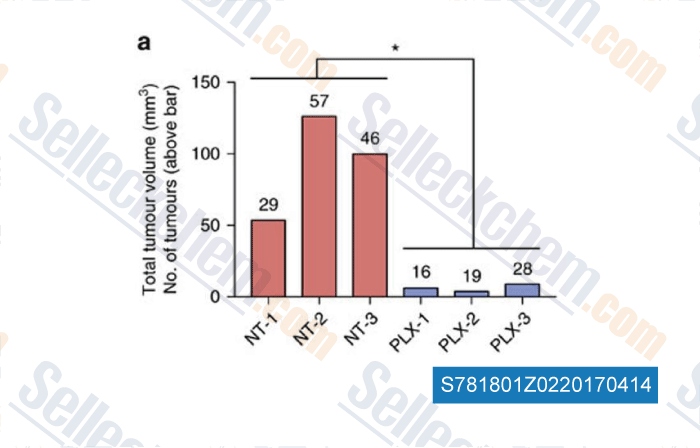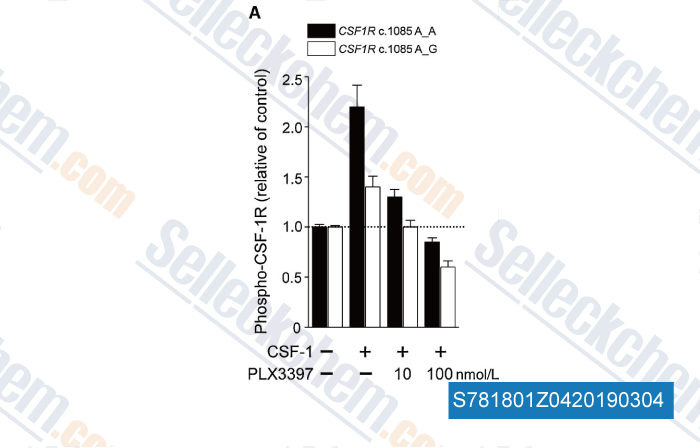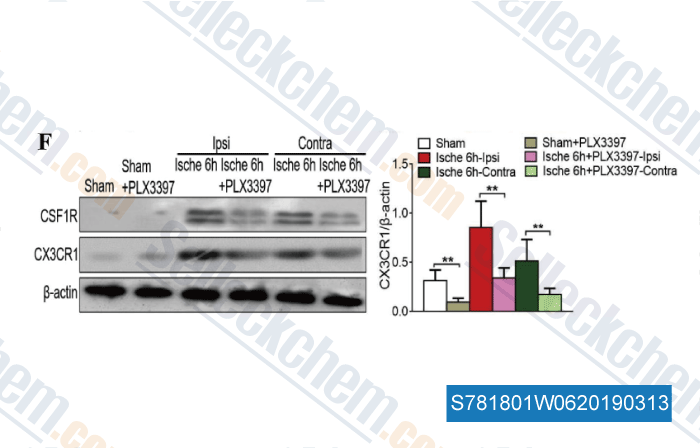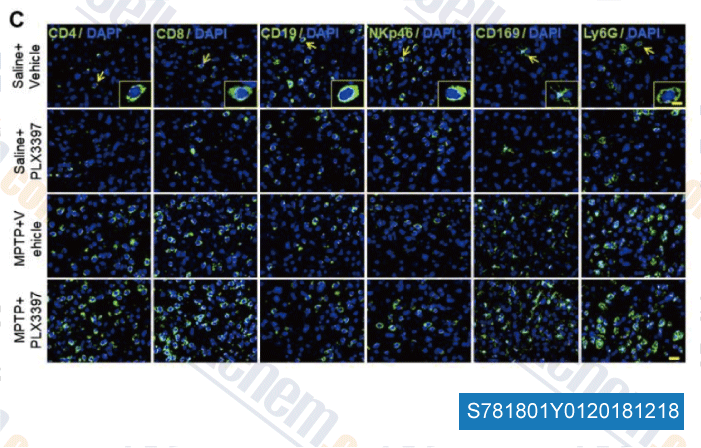|
Toll Free: (877) 796-6397 -- USA and Canada only -- |
Fax: +1-832-582-8590 Orders: +1-832-582-8158 |
Tech Support: +1-832-582-8158 Ext:3 Please provide your Order Number in the email. |
Technical Data
| Formula | C20H15ClF3N5 |
||||||
| Molecular Weight | 417.81 | CAS No. | 1029044-16-3 | ||||
| Solubility (25°C)* | In vitro | DMSO | 84 mg/mL (201.04 mM) | ||||
| Water | Insoluble | ||||||
| Ethanol | Insoluble | ||||||
| In vivo (Add solvents to the product individually and in order) |
|
||||||
|
* <1 mg/ml means slightly soluble or insoluble. * Please note that Selleck tests the solubility of all compounds in-house, and the actual solubility may differ slightly from published values. This is normal and is due to slight batch-to-batch variations. * Room temperature shipping (Stability testing shows this product can be shipped without any cooling measures.) |
|||||||
Preparing Stock Solutions
Biological Activity
| Description | Pexidartinib (PLX3397) is an oral, potent multi-targeted receptor tyrosine kinase inhibitor of CSF-1R, Kit (c-Kit), and FLT3 with IC50 of 20 nM, 10 nM and 160 nM, respectively. Pexidartinib (PLX3397) induces apoptosis and necrosis with antitumor activity. Phase 3. | ||||||
|---|---|---|---|---|---|---|---|
| Targets |
|
||||||
| In vitro | In M-NFS-60, Bac1.2F5 and M-07e cells, Pexidartinib inhibits the CSF1-dependent proliferation with IC50 of 0.44 μM, 0.22 μMand 0.1 μM, respectively. [1] |
||||||
| In vivo | In MMTV-PyMT mice, Pexidartinib (40 mg/kg, p.o.) significantly inhibits both steady-state and PTX-induced tumor infiltration by CD45+CD11b+Ly6C−Ly6G−F4/80+. Pexidartinib/PTX therapy also results in a significant reduction in CD31+ vessel density within mammary tumors, paralleling induction of apoptosis and necrosis. [1] In C57 mice bearing GL261 tumors, Pexidartinib (p.o.) inhibits glioblastoma invasion. [2] In cmo mice, PLX3397 significantly attenuates autoinflammatory disease by decreasing the erosive bone lesions in tails and paws and the levels of circulating MIP-1α. [3] In mice bearing B16F10 melanomas, Pexidartinib (45 mg/kg, p.o.) enhances CD8-mediated immunotherapy of melanoma. [4] |
Protocol (from reference)
| Kinase Assay: |
|
|---|---|
| Animal Study: |
|
References
Customer Product Validation

-
Data from [Data independently produced by , , Nat Commun, 2017, 8:14293]

-
Data from [Data independently produced by , , Clin Cancer Res, 2017, 23(20):6021-6030]

-
Data from [Data independently produced by , , Brain Behav Immun, 2018, 68:248-260]

-
Data from [Data independently produced by , , FASEB J, 2018, 32(6):3336-3345]
Selleck's Pexidartinib (PLX3397) has been cited by 123 publications
| Deciphering the preeclampsia-specific immune microenvironment and the role of pro-inflammatory macrophages at the maternal-fetal interface [ Elife, 2025, 13RP100002] | PubMed: 40152904 |
| C3/C3aR Bridges Spinal Astrocyte-Microglia Crosstalk and Accelerates Neuroinflammation in Morphine-Tolerant Rats [ CNS Neurosci Ther, 2025, 31(1):e70216] | PubMed: 39801259 |
| CDKN2A Low cancer cells outcompete macrophages for microenvironmental zinc to drive immunotherapy resistance [ bioRxiv, 2025, 2025.02.08.637227] | PubMed: 39975044 |
| The aging mouse CNS is protected by an autophagy-dependent microglia population promoted by IL-34 [ Nat Commun, 2024, 15(1):383] | PubMed: 38195627 |
| Microglial CD2AP deficiency exerts protection in an Alzheimer's disease model of amyloidosis [ Mol Neurodegener, 2024, 19(1):95] | PubMed: 39695808 |
| Destabilization of fear memory by Rac1-driven engram-microglia communication in hippocampus [ Brain Behav Immun, 2024, 119:621-636] | PubMed: 38670239 |
| Advanced paternal age exacerbates neuroinflammation in offspring via m6A modification-mediated intergenerational inheritance [ J Neuroinflammation, 2024, 21(1):249] | PubMed: 39367406 |
| Herpes simplex virus 1 accelerates the progression of Alzheimer's disease by modulating microglial phagocytosis and activating NLRP3 pathway [ J Neuroinflammation, 2024, 21(1):176] | PubMed: 39026249 |
| ptx3a+ fibroblast/epicardial cells provide a transient macrophage niche to promote heart regeneration [ Cell Rep, 2024, 43(4):114092] | PubMed: 38607913 |
| Microglial repopulation restricts ocular inflammation and choroidal neovascularization in mice [ Front Immunol, 2024, 15:1366841] | PubMed: 38711521 |
RETURN POLICY
Selleck Chemical’s Unconditional Return Policy ensures a smooth online shopping experience for our customers. If you are in any way unsatisfied with your purchase, you may return any item(s) within 7 days of receiving it. In the event of product quality issues, either protocol related or product related problems, you may return any item(s) within 365 days from the original purchase date. Please follow the instructions below when returning products.
SHIPPING AND STORAGE
Selleck products are transported at room temperature. If you receive the product at room temperature, please rest assured, the Selleck Quality Inspection Department has conducted experiments to verify that the normal temperature placement of one month will not affect the biological activity of powder products. After collecting, please store the product according to the requirements described in the datasheet. Most Selleck products are stable under the recommended conditions.
NOT FOR HUMAN, VETERINARY DIAGNOSTIC OR THERAPEUTIC USE.
